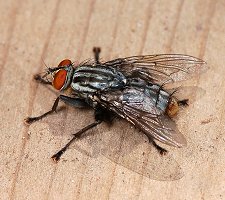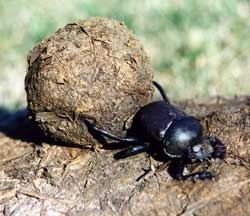Insect Decomposers

Flesh fly
The dead bodies of plants and animals are a rich source of organic matter that provides nutrition for many insects called saprophages (from the Greek words “sapros” meaning rotten and “phagein” the verb to eat or devour. Insects adapted to this lifestyle are an essential part of the biosphere because they help recycle dead organic matter.
Within the ranks of saprophagous insects, entomologists recognize several major groups:
- those that feed on dead or dying plant tissues
- those that feed on dead animals (carrion), and
- those that feed on the excrement (feces) of other animals.
The dead plant feeders include a wide variety of soil- and wood-dwelling species that shred leaves or tunnel in woody tissues. They accelerate decay by increasing the surface area exposed to weathering and the action of other decomposers. They are largely responsible for creating a layer of humus that often covers the soil. This layer serves as an incubator for the fungi, bacteria, and other microorganisms that release carbon, nitrogen, and mineral elements for uptake by living plants. Carrion feeders include numerous beetles, fly larvae (maggots), wasps, ants, mites, and others. Each species colonizes the dead body for only a limited period of time but, as a group, they rapidly consume and/or bury the decaying flesh. Blow flies, usually the first to arrive on a carcass, are also the first to complete development and depart. Other species follow over time in a relatively predictable sequence as the body decomposes. This change in the species composition of saprophages is called faunal succession. It provides a reliable way to determine the time elapsed since death and has become a useful tool for police, medical examiners, and other practicioners of forensic entomology.

Tumblebug rolling dung
Many species of manure flies and dung beetles are attracted to the odor of animal excrement. Adults lay their eggs on fresh feces and larvae feed on the organic matter in these waste products. Many dung-feeders exhibit distinct preferences for particular types of manure: the species associated with horse manure, for example, may be quite different from those found on the same farm in cattle manure. One group of dung beetles, called tumblebugs, form the excrement into a small ball and roll it into a hole that was previously dug in the soil. They lay an egg on the ball of dung and cover it with soil to serve as a nursery for their larvae.
In addition to their role as decomposers, More about
Stinking Flowers some saprophagic insects also serve as pollinators for plants like skunk cabbage and wild ginger. These plants produce drab colored, foul smelling flowers that attract the attention of blow flies or carrion beetles. The insects crawl around in the flowers looking for food and unwittingly pick up pollen. Finding nothing to eat, the insects leave and continue to forage for food, perhaps visiting another blossom and transferring pollen.

